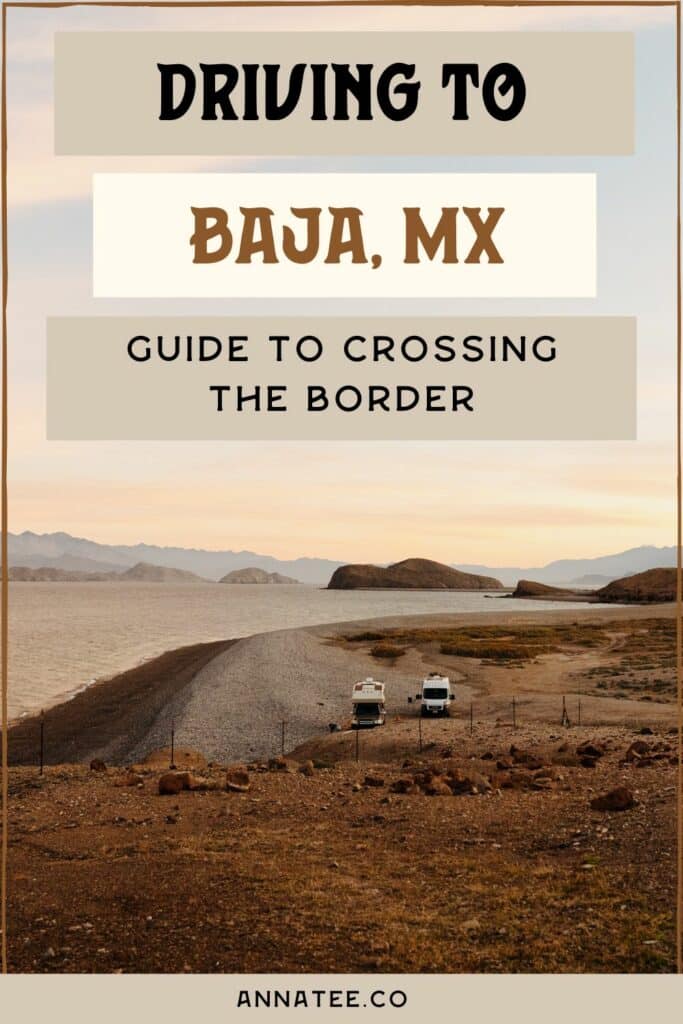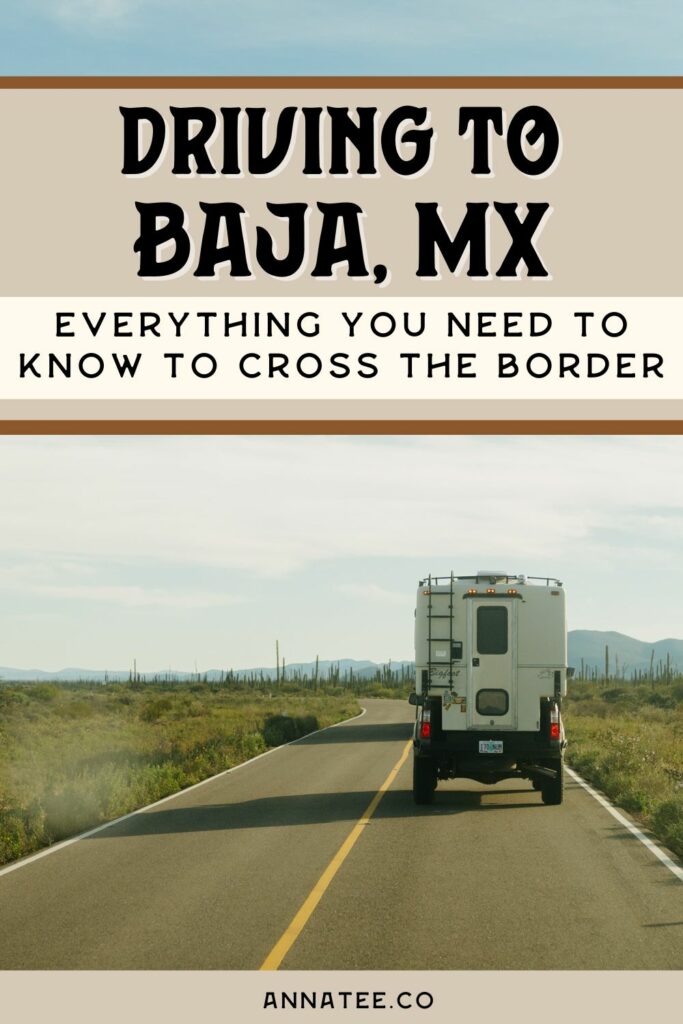Driving to Baja: Everything You Need to Know to Cross the US/Mexico Border
Driving to Baja has been on my bucket list pretty much ever since I started van life – and now that I’ve done it, I truly can’t imagine a better way to spend the winter than camping on beaches, swimming in the ocean, and eating tacos. Crossing the border into Mexico can definitely feel intimidating, as there’s more planning involved, more logistics, potentially a language barrier, and more to think about than there might be compared to traveling around your home country. But, don’t let that deter you! It’s not as hard as it may seem, and certainly not as scary as some make it sound – and it’s beyond worth it. There’s beauty in Baja that you truly can’t find anywhere in the United States.
This guide will tell you everything you need to know about driving to Baja and crossing the border from the US into Mexico!
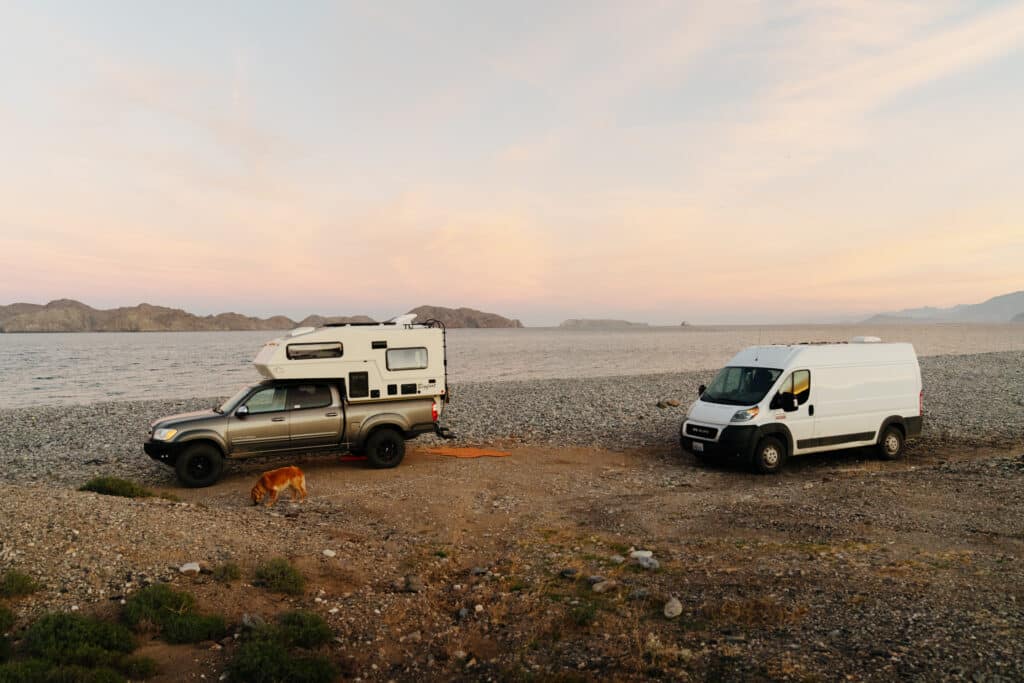
Head’s up: some of these links are affiliate links, so I get a commission if you make a purchase (at no cost to you). But that’s great, because I was going to share anyway, and this helps me keep making free guides for you!
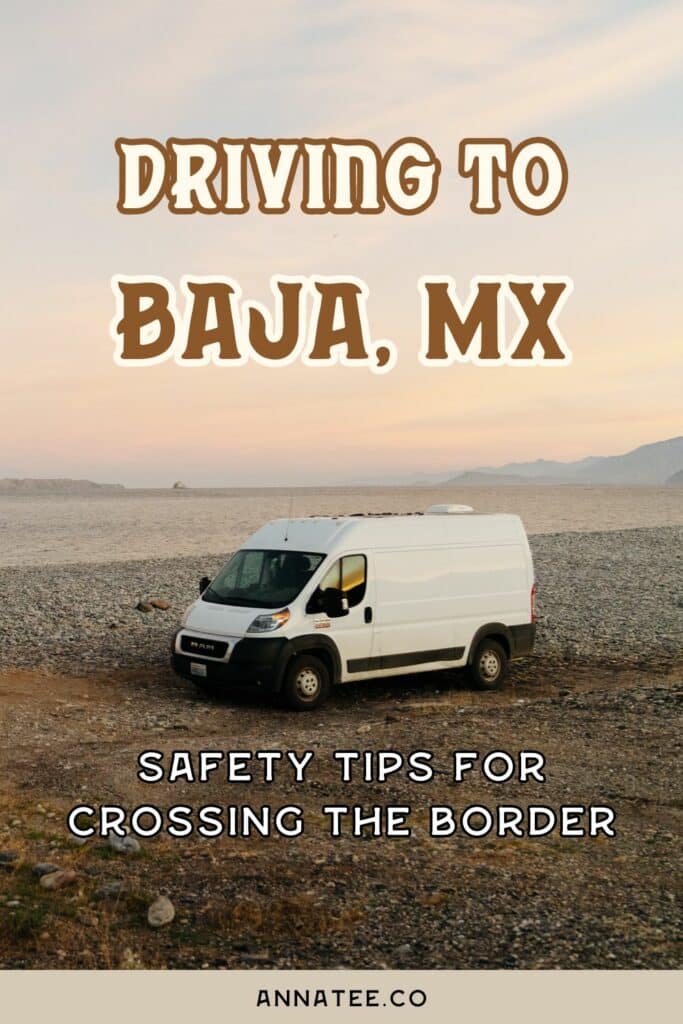
Table of Contents
Pin this photo to save this guide to Driving to Baja and reference it later!
Is it Safe to Drive to Baja?
One thing that I feel strongly about is the fearmongering that often happens in any discussion around driving to Baja, and just being in Mexico. I’m sure you’ve had the experience of telling someone that you want to drive to Baja, and had them gasp in horror and clutch their pearls.
Let’s be clear: most of this is simply racism. A lot of Americans see Mexico as this big, scary “other,” and it’s really important to check yourself and your biases. If someone speaks negatively about Baja, ask them if they’ve ever been. And if they have, ask them if they ventured outside of their resort. Most likely, the people who rant about cartels and corruption truly just don’t know what they’re talking about. Of course, that’s not to say that danger doesn’t exist in Baja – there isn’t a place in the world that’s 100% guaranteed to be safe.
Fearmongering is harmful and not okay, and I hope you don’t let it deter you from taking the trip. And listen, I’ve had the experience of being robbed at gunpoint (not in Mexico) – shit does happen. But, it is safe to drive to Baja, and I’ll talk about some concerns and tips for staying safe.
Side note… if you’re an American, one interesting fact to keep in mind is that there are several countries (like Australia) that have travel advisories/warnings for anyone visiting the US about gun violence!

Theft and Break ins
This is typically the worst case scenario when driving to Baja – bodily harm is pretty unlikely. Lock your car, don’t leave valuables in plain sight, and just be cautious, like you probably would be anywhere else.
Police
It’s not uncommon for police to stop vehicles and ask for a bribe. They will usually tell you that you can pay the ticket, or give them the money, which will cost less than the ticket. You can give them some money (don’t carry too much cash in your wallet at once – have like, 200 pesos, and keep the rest somewhere else), but you can also ask them to take you to the police station to pay the ticket. They usually won’t do this, because they can get in trouble for trying to get a bribe from you. If they do decide to take you to the station, you’ll need to give them your driver’s license and follow them. Bribing them isn’t recommended, as it does kind of perpetuate the practice, but of course it can definitely be scary to have a police officer at your door, so I get it if you decide to just give them a few pesos and go on your way.
One person in my group has had an encounter with the cops – he was pulled over and told he missed the stop sign, but all he did was argue that he did actually stop, and the police let him go and drove off. I think it probably also helped that the three of us who were driving in front of him turned around and stopped across the street when he got pulled over.
Most shakedowns happen close to the border, so I recommend not stopping anywhere after crossing and just keep going to your destination. Drive carefully and don’t give the police a real reason to stop you.
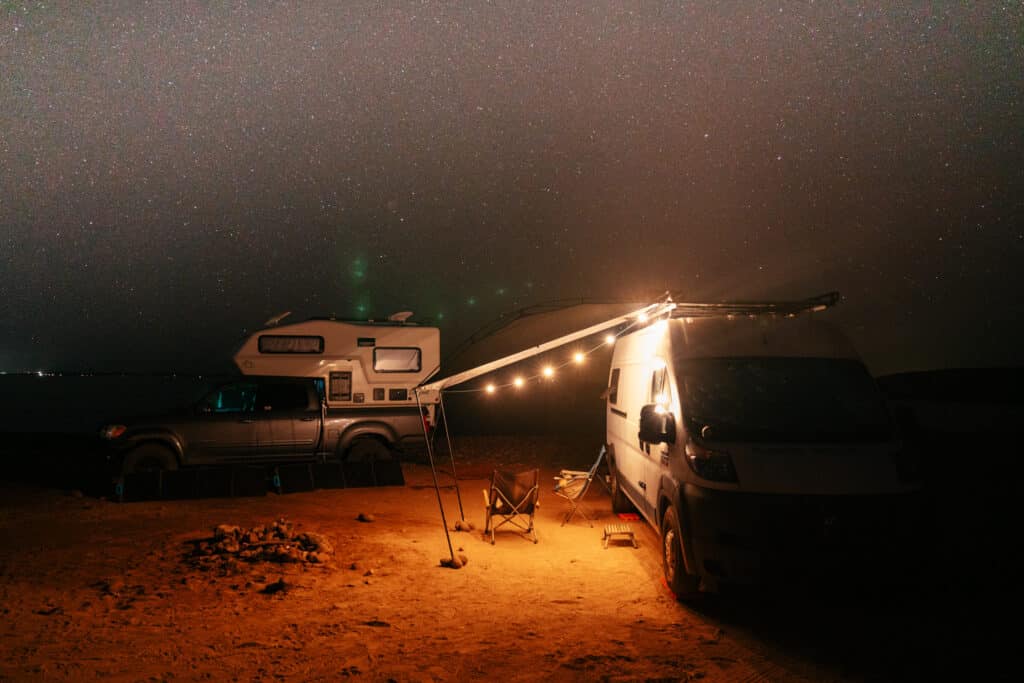
Military Checkpoints
A lot of people get intimidated by the military checkpoints, but they truly are nothing to worry about. At most military checkpoints, I was simply asked where I came from and where I was going, and then waved on. There were a few times where I was asked to open my door, but I haven’t had anyone actually search my van. If they do search your vehicle, they’re looking for illegal goods, like drugs and weapons, but obviously you shouldn’t have those with you. The most notoriously difficult checkpoint is between Guerrero Negro and San Ignacio, and a lot of people say their vehicles were thoroughly searched – but I was just waved on at that one.
If you do get searched, stay close by and keep an eye on your things. I do have a friend (who wasn’t traveling with me) who had a few things stolen from the cab while he was in the back with another officer, so don’t leave things unattended. One tip that I’ve heard from others is that if you have a speaker, you should hide it – for some reason some military officers seem to want to take them?
Tip: Spanish has two forms of “you” – the informal tú and the formal usted. Using usted (like busting out a “Cómo está usted) when you pull up to the checkpoint) with military officers as a sign of respect seems to make them happy. Also, though most of the guards I’ve encountered do speak enough English that you would be fine speaking it, I’ve gotten the feeling that speaking Spanish to them makes them think a little more fondly of you. And of course, you are in their country, so if you’re able to, brush up on your Spanish and use it!
Safety Tips for Driving in Baja
Here are a few things you can do to give you more peace of mind when driving to Baja, and some safety tips.
- Make copies of all your documents – this includes license, registration, car title, insurance, and passport. This way, if the police ask you for anything, you can give them a copy instead of the real thing (but if they’re taking you to the station, you will need to give them your real license), and if something does happen and you lose anything, you’re not totally out of luck.
- Don’t drive at night – it’s just safer to do your driving during the day, as animals can be in the road at night and you might have a harder time seeing hazards.
- Travel with friends – caravanning with friends when you drive to Baja can definitely help you feel more comfortable, and there’s always safety in numbers (and it’s fun). Bonus points if you caravan with someone who has 4×4, so that they can pull you out of the sand if needed. You’re less likely to be pulled over or questioned if you have others with you. I also recommend getting walkie talkies to communicate while driving.
- Learn some Spanish – it’s definitely more intimidating to be in a place where you don’t speak the language at all. While you can pretty much get around Baja with little to no Spanish, it’s still a good idea (and it’s respectful) to learn some basic vocabulary or to write down any phrases that you might need to know. I speak Spanish decently well thanks to 5 years of it in school, and I do feel like even though English is pretty widely spoken in Baja, speaking Spanish as much as possible when you talk to locals is not only helpful, but it’s just kinder when you’re a visitor in someone else’s country. Everyone I’ve talked to has been totally willing to help me fill in a word I don’t know (if you want to ask, say “Cómo se dice ____ in Español”), and they seem to appreciate the effort. So even if you don’t speak a lot of Spanish, what matters is that you try!
- Save the number for the Green Angels – the Green Angels are a program similar to AAA in the US, and they provide free travel info and mechanical assistance for anyone driving in Mexico. They also speak English. Save their number in case you break down in Baja! It’s 078.

Do You Need 4×4 to Drive to Baja?
This is a commonly asked question about driving to Baja. The answer is no, you don’t need 4×4. Of course, there are some places where it definitely would be helpful, and some places where you won’t be able to go without it, but it’s absolutely possible to enjoy Baja without it. I drove to Baja in my FWD Promaster, and made it to plenty of beautiful, secluded beaches.
Big rigs, like RVs and trailers will definitely be more limited in where you can go, but it’s definitely still worth it! Keep in mind that some roads are pretty narrow, so it can be a little stressful with a bigger vehicle.
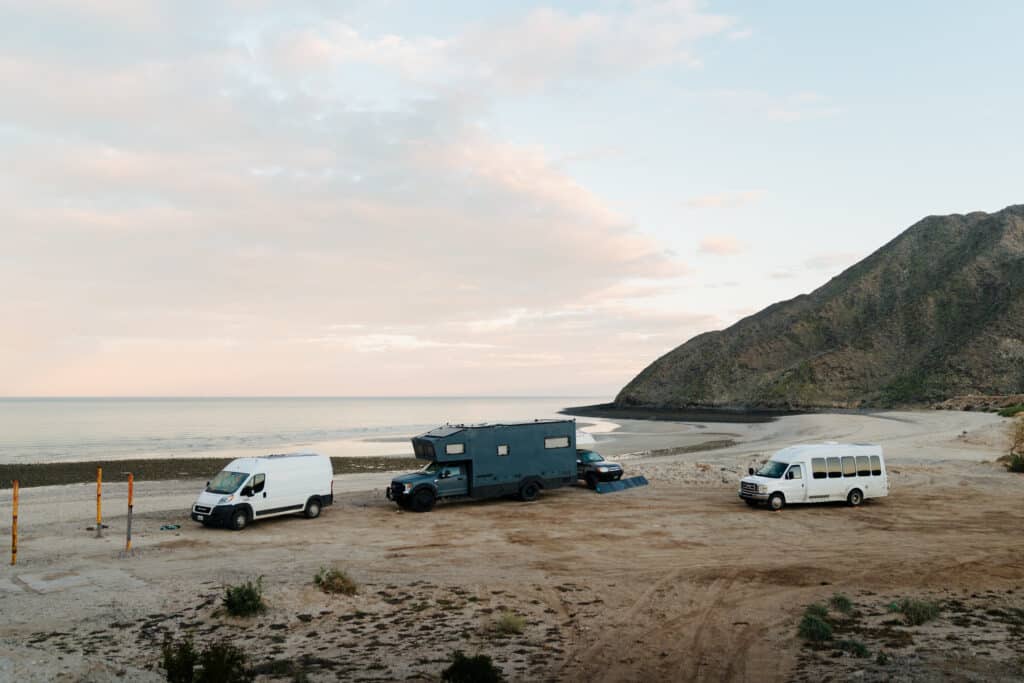
What is the Easiest Border Crossing to Baja?
One of the first steps for driving to Baja is deciding where you’ll cross. There are several crossings you can take. I definitely recommend crossing at Mexicali, as those are much less busy.
Tijuana
- San Ysidro – I’ve taken this one once on a day trip to Tijuana. It’s very busy and hectic, with long lines. My van got searched pretty thoroughly and sent to the x-ray machine.
- Otay Mesa
- Tecate
Mexicali
- Calexico West/Mexicali I
- Calexico East/Mexicali II – this is the one I took for my road trip through Baja. It was quick and easy, with no line. They searched a few of my cabinets, but overall it was easy.
- Andrade/Los Algodones – not recommended for big rigs, as roads are really narrow.
Overall, I recommend Mexicali east. One thing to keep in mind when you cross is that you need to get an FMM, and the offices are often not open until 9. More on how to get the FMM later in this guide!
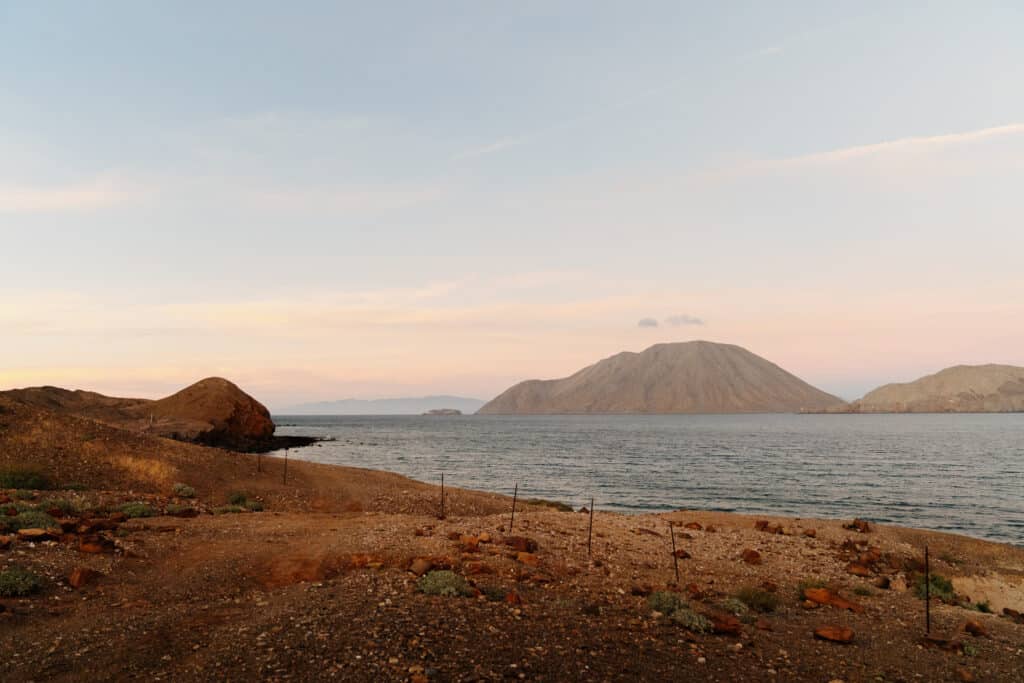
Car Insurance for Driving to Baja
A Mexican car insurance policy is required for driving to Baja. By law, you at least need liability coverage – and US insurance policies typically are not accepted (though it may be worth calling your insurance company to check). Driving without insurance is illegal in Baja, and can get you in serious trouble if anything were to happen. Make sure you get insurance before you get to Baja!
The car insurance that I used for my Baja road trip was Baja Bound. They insure cars, camper vans (including self converted ones), motorcycles, RVs, and more – and the process is really quick and easy. You can get a quote online in minutes, and the prices are fairly reasonable.
If you’re going for more than about three weeks, it’ll likely be cheaper to get a six month policy – and this way you don’t have to have an exact date in mind for when you’re leaving Baja. I paid $363.50 (USD) for car insurance though Baja Bound, with a six month policy. I *knock on wood* haven’t had to use it, but have a few friends who have needed to in the past – and they have all said that their experience with Baja Bound was easy and that they were super responsive when it came to claims.
A few things to note about your Baja car insurance:
- Baja Bound only works on conventional roads (which is typical of insurance both in Baja and in the states). Beaches, off roading, and anything off of “real” roads isn’t covered.
- My US car insurance is through State Farm, and I was able to call them and suspend my US policy for the time I would be in Baja, saving some money. I definitely recommend calling your insurance company to do the same!
- Make sure to print out your insurance documents before your trip. You will need them if something happens, or if you’re asked for proof of insurance by a cop or at a military checkpoint.

What You Need for Driving to Baja
Here’s what you need to drive to Baja!
Car Insurance
See the section above for more details on car insurance! I went with Baja Bound. Make sure to print out your insurance documents!
FMM
The FMM (Forma Migratoria Múltiple) is basically a visitor’s permit allowing you to be in Mexico. You will need to get the FMM as soon as you cross the border – but it can be confusing, as they won’t tell you to do it, and the buildings are often not well marked. I crossed at Mexicali east, and just parked on the side of the road to go into the office. Don’t hesitate to ask the border agents for help – they’ll be able to direct you to the office.
Bring your passport with you, and once you’re in the office, you’ll get the form, fill it out, and they will stamp it for you. When asked how many days you’re staying in Mexico, I recommend saying 180 – this is the maximum limit, and you can always leave earlier, so it just gives you more time in case you extend your trip. The FMM cost 717 pesos when I went (January 2024), which was about $42. If you’re staying for less than 7 days, it’s free.
It is also possible to apply for the FMM ahead of time online – however, it’s not recommended to do so. You will need to print your form and your receipt, and will still need to go into the office to get it stamped. Sometimes they will ask you to pay again anyway, so it’s better to just fill it out at the office.
Vaccine Records for Pets
If you’re driving to Baja with pets, you will need to print out their vaccine records. I know several people who brought dogs or cats to Baja who say they have never been asked for their records, but of course, it’s better to have them and not need them than the other way around.
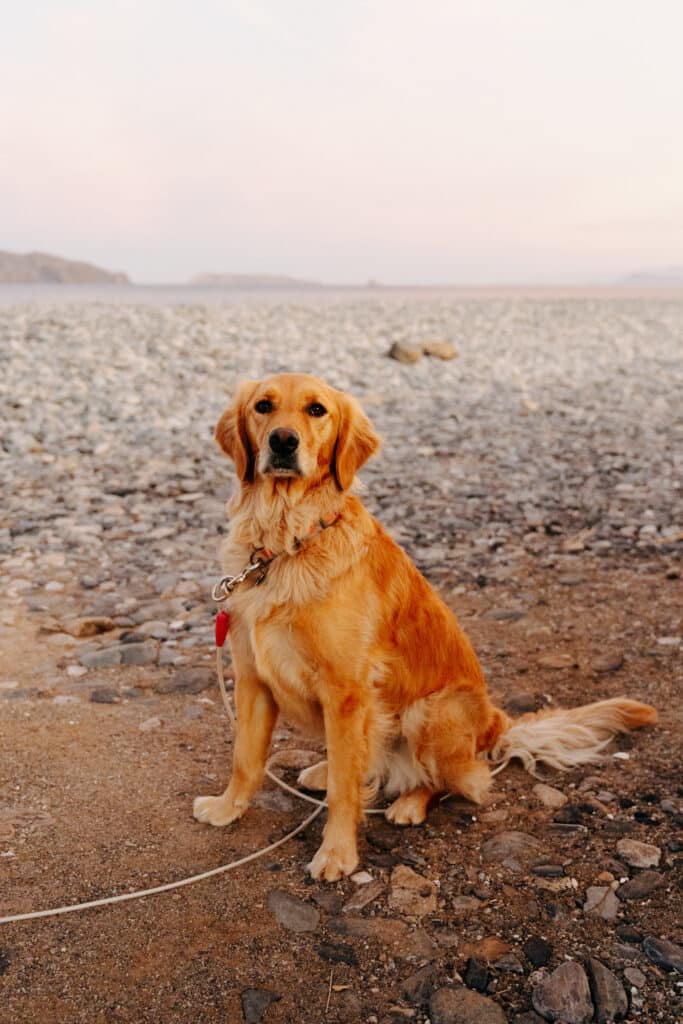
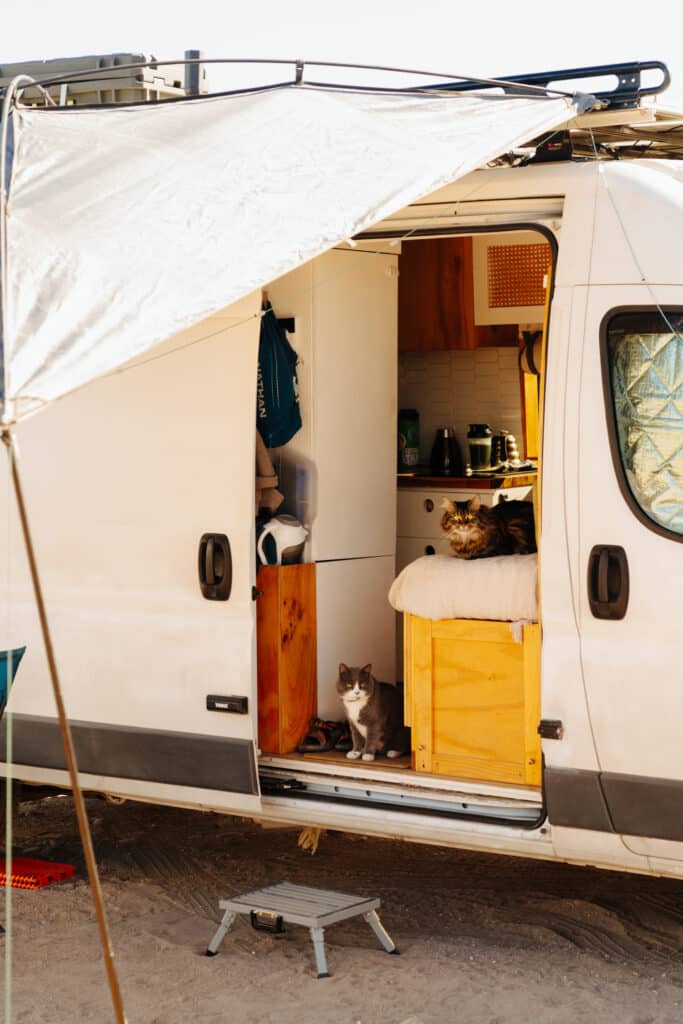
Copies of Documents
It’s always a good idea to make copies of your documents when driving to Baja. I recommend copying your car’s registration and title, your passport, and your driver’s license. I made three of each, and left one set of copies in my glove compartment and the others in a drawer in the back of my van. Of course, bring all the originals too.
This is mostly in case you get pulled over by the cops in an attempt to get a bribe – if they ask for documents, you can give them the copy instead. However, if you end up going to the station with them to pay a fine, you will need to hand over your actual license.
What You Can’t Bring When Driving to Baja
When you’re driving to Baja, there might be a few things you’ll need to get rid of before crossing the border. Don’t bring these things into Mexico:
- Guns and other weapons, including pepper spray
- Fruits and vegetables
- Meat
- Drugs (even CBD isn’t allowed)
- Alcohol is allowed, but no more than one liter or one case of beer
- Plants and soil – this seems to depend on the officer, as I know a few people who have brought their plants with no problem, and a few who have had them confiscated.
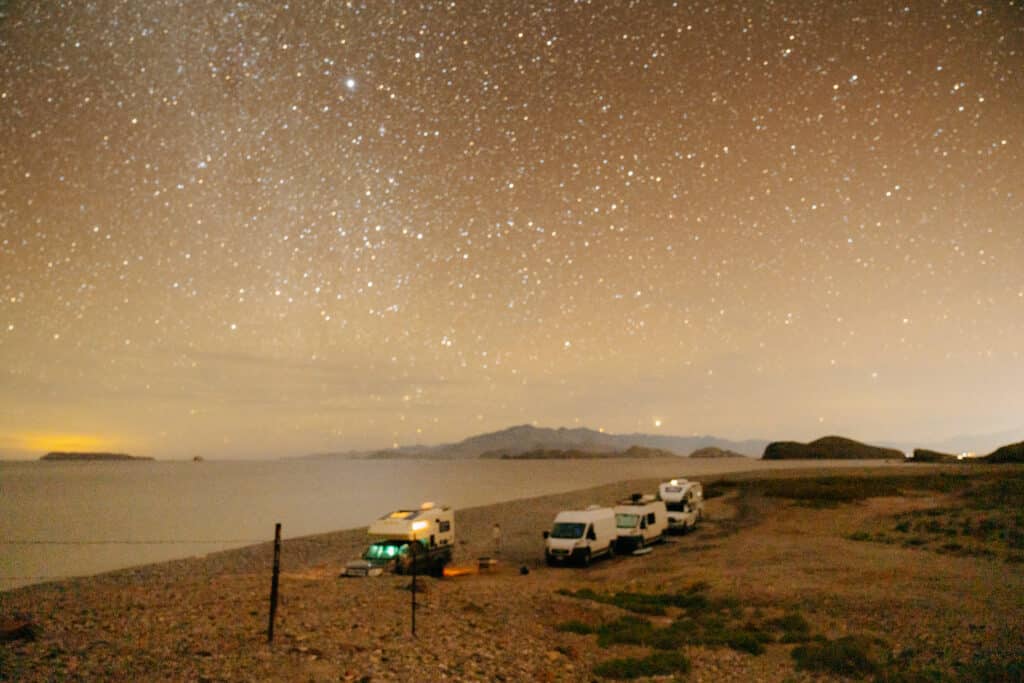
What You Need for Driving to Baja
Driving to Baja often means driving on sandy beaches and bumpy roads. Here are a few things I recommend bringing to make sure you stay safe and are prepared!
- MaxTrax – recovery boards are important for getting out of the sand! If you get stuck on a beach, these help a ton. I bought some cheaper off brand ones, and have used them a few times and they’ve worked well and held up just fine. been fine. But, MaxTrax are typically the recommended option and likely would last longer.
- Tire deflator – airing down your tires increases traction, and can help you drive on beaches.
- Air compressor – if you air down, you also need a way to reinflate your tires!
- Tow strap – if you do get stuck, there usually will be someone around willing to help, and having a tow strap ensures that they can get you out.
- Walkie talkies – these are super useful for caravanning, as it lets you communicate about pit stops, hazards, and anything else you might encounter.
- Starlink – you don’t need a Starlink of course, but there’s minimal service in Baja, especially once you get away from the big towns. If you’re working during your trip, this is definitely the best way to ensure Internet access.
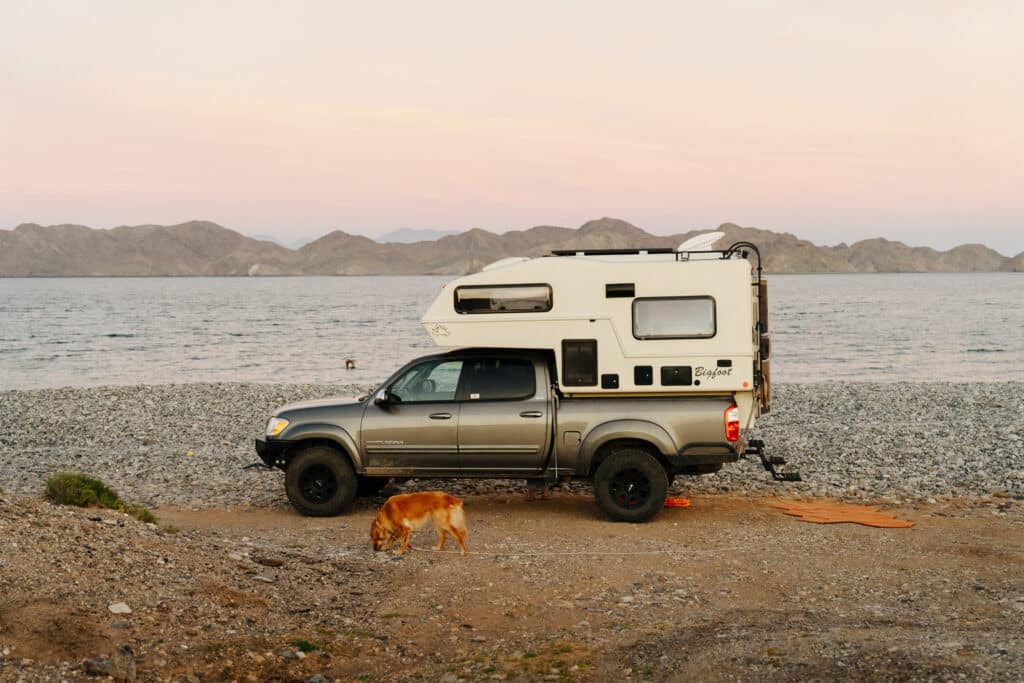
Ready to Drive to Baja?
Though driving to Baja can have some challenges, as long as you’re prepared and know what to expect, it’ll be a beautiful experience! If you have any questions about driving to Baja, or some advice that I didn’t mention, let me know in a comment below.
For more Baja resources, check out this guide to camping in Baja, and this one about crossing the border. To plan a road trip, here’s a Baja road trip itinerary that covers the entire peninsula!
Pin any of these photos to save this guide to Driving to Baja for later!

